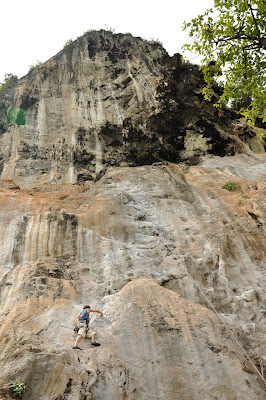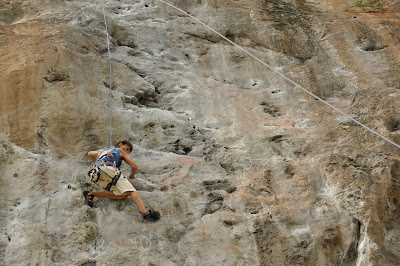At the Photokina last week, I got to spend a good 1/2 hour with a pre-production model of the Panasonic Lumix GH2, and so got it on a UCA, behind a telescope to check it out for digiscoping.

The new Panasonic Lumix GH2, ready for digiscoping
The GH2 is Panasonic's latest mirror-less micro 4/3s system camera and features a 16MP 17.3x13.0mm sensor. I was not allowed to put my memory card in to the GH2, but looking at the images on the camera, the performance at 800 ISO was surprisingly good (better than the G2?) and certainly usable for most situations. Given that the sensor is smaller than the average DSLR's APS-C sensor, the camera needs less light to get a usable shutter speed, and it has no mirror flap, so this ISO800 is likely to be more than useful for digiscoping.

Showing off what the GH2 can do. Resolving absolutely incredibly tiny dots on a tin that was a good 10m away (just under the TV on the back wall, by the star. tin is about the size of the star). Swarovski ATM65 HD, 25-50x eyepiece, 45mm Objective, Panasonic GH2.
We tested 3 objectives on a Swarovski ATM65 HD with 25-50x wide-angle eyepiece:
- 20mm f1.7 pancake. no vignetting when eyepiece >28x.
- 45mm f2.8 Leica. no vignetting. exceptional resolution. expensive ($900)
- 3D objective 12.5mm f12.0. no vignetting above about 30x. Very interesting.

Jörg Kretzschmar admiring the new Panasonic GH2. I think he is stroking it. Jörg is one of the most incredible digiscopers I have ever come across. His work is like hot chocolate for the eyes. www.ozellus.de
So, what stood out about the GH2 for digiscoping?
1. 40 frames per second burst photo mode (great for action sequences)
2. Good autofocus.
Published figures claim 0.099secs - the equivalent of many a DSLR. I have found the G2 to be pretty quick (0.2s) and reliable in most situations, the GH2 contrast detect was looking pretty good in the dull, artificial light of the exhibition hall. The focus of the GH2 might, not be as quick as a good DSLR or - for that matter - does not come close to the shockingly quick autofocus of the new Sony a33 and a55 system cameras (which use beam-splitting phase detect autofocus), but these other cameras will not autofocus reliably through a spotting scope (I tried). The GH2 remains the quickest autofocus system for digiscoping I have come across.
3. Touch screen.
The GH2 seems to have exactly the same touch screen as the G2, a feature I have found more than just a gimmick (which is what I had initially passed it off as). Being able to tap your focal point (and having it followed!) can really be rather useful in a digiscoping situation to make sure you are focussing on the Red-breasted Goose and not the White-fronteds.

The first digiscoping photo with the Lumix GH2? on a Swarovski ATM65 HD.
4. Improved Electronic viewfinder.
EVF technology is developing quickly. At 1,533,600 dots, a 100% view and a magnification of 0,71% (Nikon D3 = 0,7x and Canon 1Ds = 0,76x), the GH2s electronic viewfinder looks good. It is still nowhere near an optical viewfinder, but it is likely to be rather useful for digiscoping when the sun is shining from unhelpful angles.
5. Full HD video.
I suppose many would have guessed by now how much I enjoy video digiscoping and how much fund I think it is. The ability to take full HD video (Motion Jpeg, AVCHD, AVCHD Lite Pal) at up to 50 fps is something that really stands out. External jacks allow for HDMI direct output
and input from an external microphone.
This camera is bound to be a lot of fun and if we had not just bought the Panasonic Lumix G2 (which I am coming to love), I would seriously think about this camera. Maybe at the end of the year...
First delivery: November 2010
Suggested Retail Price: €900 (without objective)
Happy digiscoping,
Dale Forbes






















.jpg)



